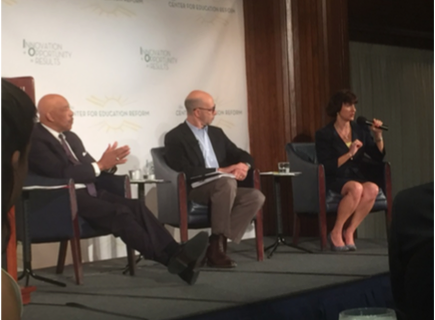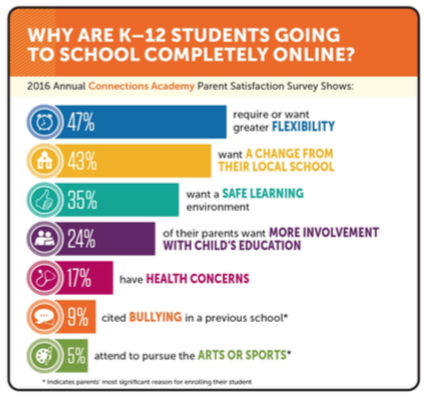A Call to Action for Renewed Focus on REAL Education Reform
by Steven Guttentag, President of Connections Education
On Wednesday June 15th, I attended a lunch at the National Press Club at the invitation of Jeanne Allen, founder and CEO of the Center for Education Reform, and a long-time, tireless and effective supporter of choice and charters. At this event, Jeanne unveiled The New Opportunity Agenda, a manifesto for renewed energy, strategy and action around education innovation and opportunity.
In a nutshell, Jeanne and the panel argued that the progress made over the last 25 years around creating educational choices for all parents (not just the privileged few who can afford private schools) and the development of new educational models, practices and pedagogy, is starting to wane. In some cases, it seems to be even going backwards. She provided a wake- up call to education reformers and asked all of us, across the ideological spectrum, to find common ground around the “twin values of opportunity and upward mobility.”
As someone who has been on the front lines of education reform my entire career, first as a teacher in the District of Columbia Public Schools, then as an administrator in the School District of Philadelphia and now as a co-founder and president of Connections Education, a company supporting K-12 online and blended learning in schools and school systems across the country for 15 years, this was a message for which I had been waiting. Attempting to innovate within our public education system is a constant battle to fit a square peg into a round hole—to justify, to explain, to try to comply with antiquated rules and regulations.
Joining Jeanne at the front of the room in support of this change agenda was John Engler, Former Governor of Michigan, David Levin, President and CEO of McGraw-Hill Education, and Donald Hense, Chair and CEO of Friendship Public Charter Schools. This diverse panel spoke passionately and personally about today’s challenges and the need to reignite the push for change. And, an equally diverse audience asked thought provoking questions during the session.
 I left the lunch meeting feeling inspired and energized; filled with new ideas to try,
I left the lunch meeting feeling inspired and energized; filled with new ideas to try,
groups with which to collaborate and ways to engage the students and their families who desire the option to select the type of school that is the best fit for their educational needs.
On the heels of Jeanne’s meeting, a new report was released on June 16th: A Call to Action to Improve the Quality of Full-time Virtual Charter Public School. While the title was promising (any school can and should always strive to improve), the content was the same old tired criticisms borne of ignorance, faulty research or reliance on overly simplistic measures. Despite repeating several times that the authors “support full-time virtual schooling,” in reality most of the recommendations will have the effect of limiting choice for students (likely creating the same type of waiting lists and lotteries that are common among traditional charter schools and district choice programs), stifling innovation and creativity, and generally working to push this groundbreaking, personalized, life-changing (some parents even say “lifesaving”) new form of learning into a rigid framework. Equally troubling, the authors of A Call to Action are attempting to single out virtual schools into a separate (but not equal) category of schooling with more regulations and bureaucracy and fewer resources than even traditional charters (that already get fewer resources than traditional public schools).
While the virtual schools we support
are free public schools, many families
make huge personal sacrifices to have
a parent or other caring adult stay
home with a child to serve as Learning
Coach alongside licensed teachers – these parents have chosen the opportunity to support and engage with their child’s education at an unprecedented level. And as noted but not explored in the report, full-time virtuals serve a higher percentage of students in poverty than traditional public schools. So where in A Call To Action are students and families who choose these virtual schools by the thousands? What does A Call To Action say about their ability to make choices for their children?
I don’t have the answers to these questions but the timing of the release of this report by the National Alliance for Public Charter Schools, the National Association of Charter School Authorizers and 50CAN was helpful, as it was released right after The Center for Education Reform’s presentation of The New Opportunity Agenda. A Call To Action demonstrates the importance and need for a renewed focus on real reform.
We need to rewrite the equation proposed by A Call To Action, which amounts to: “Rules + Regulations + Limitations = Results.” Rather we need to embrace the equation proposed in The New Opportunity Agenda: “Innovation + Opportunity = Results.”
Experienced online and blended providers were not consulted or given the opportunity to provide information for this report, even though we attempted to repeatedly. I always welcome the opportunity to meet with individuals or organizations that would like to discuss online education – challenges, opportunities, and innovation. Connections Education is in this for the long haul and we are committed to making –better– online learning and school options available to children everywhere.















One reason that school reform is mired in a lethargic groping towards an ineffectual result, is the personal schema’s of success that “educated” individuals rely upon for their models. The vast majority of education reform individuals have achieved, what they see as success, from working inside of the traditional system of education. They cannot but have their personal definition of success be derived from that model. To truly change education in this country, the old model of “school” must be questioned in its entirety. If we continue to measure success by our own “educated” experiences and confound that analysis by the limited understanding of a “career”, school reform cannot and will not change. Understanding that learning takes place at different times, in different ways, and through different processes has been an important first step. Creating the system of providing this opportunity is what is lacking. The age cohort model has been shown to be a dismal failure in today’s electronic age. Access to information is the division between when someone learns something and when they do not. Preparing an individual to be successful in a specific field has been determined, again by the “educated” reformers, as being detrimental to the full range of opportunity available for this person’s future. Unfortunately, this perspective is once again based upon a view of the 30-40 year career. Today’s young learners may have 10 to 15 careers that can, and possibly will, span 60-80 years. Life-long learning is more of the practical answer than preparing someone with a mile-wide and an inch-deep education. Education reform must break the shackles of the schema’s held by the reformers, if it is really to succeed.